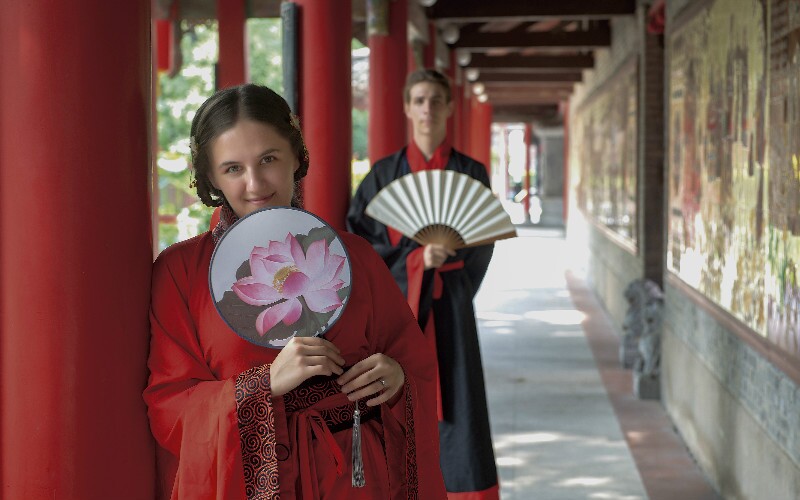Hanfu, literally 'Han clothes', is one of the traditional types of Chinese clothing.
It served asthe characteristic clothing for the Han ethnic groupfor more than three millennia and was outlawed at the beginning of the Qing Dynasty (1644–1912).
What Hanfu Is

The term "Hanfu" refers tothe historical dress of the Han peoplefor all of history before theQing Dynasty, when the Manchus reigned.
In recent years, when Chinese people talk about Hanfu, they usually meana long flowing robewith loose sleeves and a belt at the waist. However, Hanfu isa diverse termincluding different styles of clothing from different dynasties.
Features of Hanfu
Hanfu features a looseyi(/ee/) 衣 'upper garment') with sleeves, and a skirt-likeshang(/shung/ 裳 'lower garment' ). The belt sash was often decorated with jade.
It is considereda symbol of authentic Chinese culture, reflecting Confucian scholars' aspirations towards rituals, music, and moralistic ideals.
The Legendary Origin of Hanfu
It is said that Hanfu can betraced back more than 4,000 years, when the legendary Yellow Emperor's (2698–2598 BC) consort, Leizu, made clothes with silk.
However,no archaeological evidence has been unearthedto support this.
Hanfu in the Xia and Shang Periods (2070–1046 BC)
In theXia Dynasty(2070–1600 BC), top-bottom clothes prevailed. The basic form of the Hanfu was established in theShang Dynasty(1600–1046 BC)…
Theyiwas a narrow-cuffed, knee-length tunic tied with a sash. Theshangwas anarrow, ankle-length skirt. Outside a knee-length apron orbixi(/bee-hsee/ 蔽膝 'cover the knees') was worn.
Due to limited technology, there wereonly two primary colors: red and green.
Hanfu in the Zhou Dynasty (1045 – 221 BC)
In theWestern Zhou era(1045 – 771 BC), Kings of the Western Zhou Dynasty set up astrict hierarchical systemlinked by blood lineage and ethical norms based on families.
Clothes were used as a status symbolto accentuate their privileges, which had a substantial impact on clothes and ornaments, owing to great differences between the nobility and the common people.
Shenyi(one-piece clothing) andMianfu(a religious court dress of ancient emperors and officials) emerged in the Eastern Zhou period (770 – 221 BC).
Hanfusleeves were made wider, and the outer tunic was closed with jade decorations or a sash. The cross-over collar appeared.
Other ethnic groups' clothing, such ashufu(clothes of northern ethnic groups such as the Huns), was established and blended with Hanfu.
Hanfu in the Qin and Han Dynasties (221 BC – 220 AD)
During theQinandHandynasties,few changes were madeto the details of the Hanfu. Theshenyiwas still the favored style of dress for the Han people and the Huns alike.
A new kind of formal dress,pao (袍), a robe made of linen, prevailed.
It was stipulatedthat the third-rank officials and above wore green silkpaoandshenyi, and the common people wore white linenpaoduring the Qin Dynasty.
Hanfu in the Sui, Tang, and Song Dynasties (581 – 1279)
TheSuiandTangdynasties were"China's golden age", when the Han culture broadened. Based on their predecessors, a clothing style combining elements of the Hanfu and thehufubecame common.
Women's clothes becamemore relaxed and revealingthan their previous counterparts, owing to women being less restricted by theConfucianethical codes.
The clothes of theSong Dynastylargely continued the style of the Tang Dynasty.More decorations and embroiderywere applied. Women in the Song Dynasty worebeizi(褙子,similar to capes).
Hanfu in the Yuan Dynasty (1279 – 1368)
TheYuan Dynastywasthe first foreign-ruled era in China. The Hanfu in this period adopted features from the Mongolian rulers' national dress.
Men not onlywore the traditional Han-style round-collarpao, but also wore the Mongolianzhisunfu(jisumin Mongolian).
Thisfeatured anyi(upper garment) that reached the knees with narrow sleeves and a shortshang(lower garment).
Hanfu in the Ming Dynasty (1368 – 1644)
TheMing Dynastywasthe last Han-led dynasty. The emperor wanted to restore the whole Han culture and tradition, including restoring all the clothing fashions of the Tang Dynasty.
However,lots of Mongolian-style attire and hatsstill prevailed, as did clothing changes from the Song era.
儒家规范是re-popularizedand women's clothes were prone to being more conservative.
The upper outer garmentwas shorter and the lower garment was longer, and the outer coat became longer to shorten the exposed skirt's length.
Hanfu in the Qing Dynasty (1644 – 1912)
In 1644, the Manchus started ruling China, anda dramatic shiftin hairstyling and clothing occurred.
At the very beginning,Manchu leader required all the Han people to wear the Manchus' long gown, orcheongsam, but this restriction loosened soon afterward.
Three types of clothes coexistedtogether in theQing Dynasty: Han traditional clothes (i.e. Hanfu), Manchu clothes, and part Western-style clothes in the late Qing Dynasty.
汉服在Ea的影响力st Asia
Hanfu wasa symbol of traditional Chinese culture.
It also hada far-reaching influenceon the clothing in other neighboring Asian countries, such as the Japanese kimono, the Korean hanbok, and the Vietnamese Áo giao lĩnh.
Chinese clothing startedto be adopted by the Japanesein the 5th century.
Traditional Japanese clothingis the kimono. The other term for it isgofuku, which means "clothing of Wu". Wu was one of China'sThree Kingdoms(220–280).
Hanfu in Modern Times

After falling out of fashion for more than 400 years,a renaissance of Hanfuwas called for by many Han ethnic groups as part of a trend that the public should be proud of their Chinese culture.
Many supporters believe that wearing Hanfu brings them一个强烈of national identity.
Many universities in China have aHanfu Societywhose members wear Hanfu to celebrate traditional Chinese festivals, and they use that opportunity to introduce their Hanfu garments to others.









